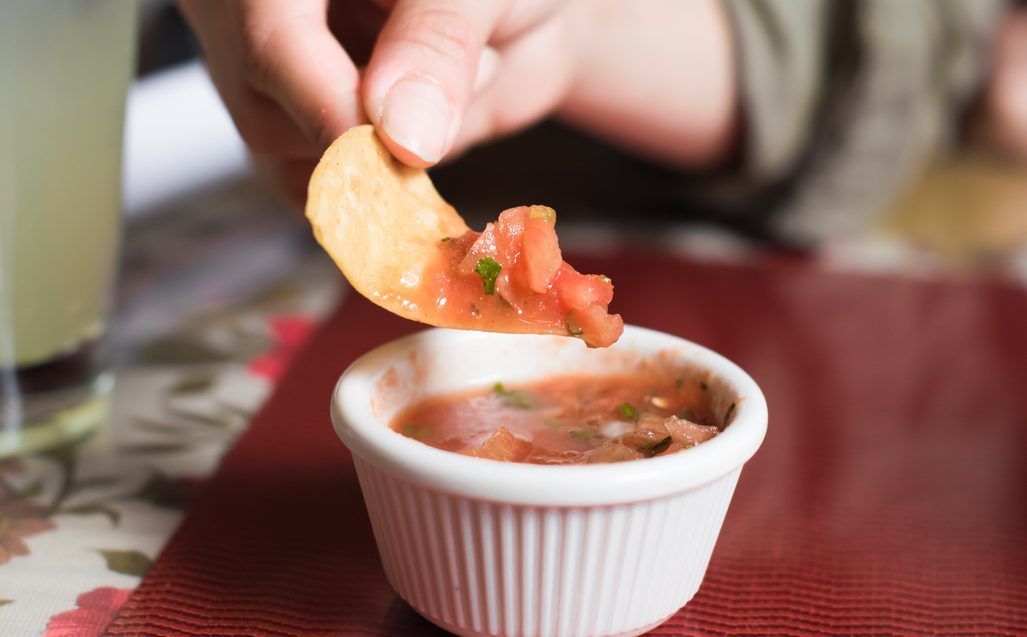
THEY’RE the menace hiding on everyday objects.
Where there are people, there are germs – and some where we least expect it.
And last week a study from Harvard University showed bacteria are an unexpected hazard at dinner parties and barbecues.
Hygiene experts warned against dunking half-eaten crisps in shared bowls of dip.
“Double-dipping” is when you dip a crisp or cracker, take a bite and return it to the bowl for more.
It is a surefire way of sharing germs which can cause a host of illnesses.
In fact, a cracker dipped in salsa three times was shown to spread 10,000 bacteria from mouth to dip, according to the
study.
The average mouth is home to 1000 different types of bacteria including some which are life-threatening, such as E. coli and staphylococcus.
But dinner party dips aren’t the only hidden germ hotspots we face in everyday life.
We spend much of our day-to-day lives in contact with these bacteria – but there’s not much we can do about it, according to microbiologist Professor Sally Bloomfield.
“We’re hard-wired to be on the lookout for dirt when we’re cleaning,” explained Professor Bloomfield.
“We know that there’s a link between the dirt we can see and disease.
“But we’re not as good as identifying the areas where there might be germs, because they’re invisible.
“There are objects and areas in everyday life which are vehicles for nasty bacteria.
“But it’s important to remember that places such as petrol pumps, handrails and trolleys aren’t the source of germs.
“They come from people, food or animals.
“And there’s no real way we can eliminate these unseen germs from everyday life, either.
“The best way to approach it is to wash your hands.
“I’m sure we’ve all done it but recently I was travelling for much of the day – touching door buttons and handles –before heading for a hamburger.
“It’s easy to blame the burger bar but they’re not likely to be to blame for me being quite ill afterwards.”
Here’s The Sunday Post guide to the 10 grubby worst-offenders.
Shopping trolleys
Supermarket trolleys can contain more bacteria than an average public toilet.
In fact, a study in 2011 showed that 72% of all trolleys tested came up positive for faecal bacteria.
Trolleys were dirtier than toilets, according to the research, because they were rarely disinfected, unlike lavatories.
Buttons on buses
Worryingly, more than one in four commuters has bacteria from faeces on their hands, says a study by the Hygiene Centre at the London School of Hygiene & Tropical Medicine.
And it also reveals people who had recently travelled by bus were six times more likely to require a visit to a doctor than those avoiding public transport.
Petrol pumps
The price of petrol may make you feel sick sometimes – but pumping fuel can really make you ill!
An Australian study showed 71% of petrol pump handles were “highly contaminated” with microbes that can cause illness.
And petrol pumps were shown to carry more bacteria than other germ hotspots such as cash machines.
Lemons and limes
They brighten up a drink but often you’re better passing on a wedge of lemon or lime when you order a coke or gin & tonic at your local restaurant or pub.
Research has found dozens of organisms living on citrus fruit wedges, including E. coli.
Make-up samples
The free make-up samples in high street shops can be a hotbed of bacteria.
A 2005 study even showed all make-up tested was contaminated with bacteria such as staphylococcus.
Microbiologists advise against using in-store samples.
Cleaning sponges
It’s a common tactic to give a dirty surface a wipe with a cleaning cloth or a sponge.
But these cloths are the dirtiest places in the home.
Each can harbour billions of bacteria, including staphylococcus and salmonella.
So it’s a good idea to rinse them out well and keep them out of the sink so they can dry.
Exercise bikes
The gym is where you go to get healthy, but exercise bikes certainly aren’t.
Exercise bikes had 39-times more bacteria than a cafeteria tray, according to some research this year.
In fact, a whopping 63% of all gym equipment is contaminated with rhinovirus – which causes the common cold.
TV remote controls
Hotel owners may clean the sheets and scrub the toilets, but the most contaminated item in a hotel room is actually the remote control.
A third of remotes – which are germ hotspots thanks to the raised-button design – are contaminated with faecal bacteria and other bodily fluids, a recent survey showed.
Handrails on public staircases
Touching a handrail has been likened to shaking hands with 1000 people.
A study has shown escalator handrails carry E. coli, urine, mucus, faeces, and even blood.
Experts advise you avoid touching them entirely or, if you do, wash your hands thoroughly with handwash.
Restaurant menus
Unlike other areas in your average restaurant, menus are rarely cleaned.
That’s why experts recommend that you wash your hands after touching a menu.
Salt and pepper shakers, as well as tomato sauce bottles, are also seldom disinfected – so it’s recommended you protect yourself by using a napkin to hold them.
READ MORE

Enjoy the convenience of having The Sunday Post delivered as a digital ePaper straight to your smartphone, tablet or computer.
Subscribe for only £5.49 a month and enjoy all the benefits of the printed paper as a digital replica.
Subscribe